X-Men ’97 Easter eggs: All Marvel Comics & movie references explained
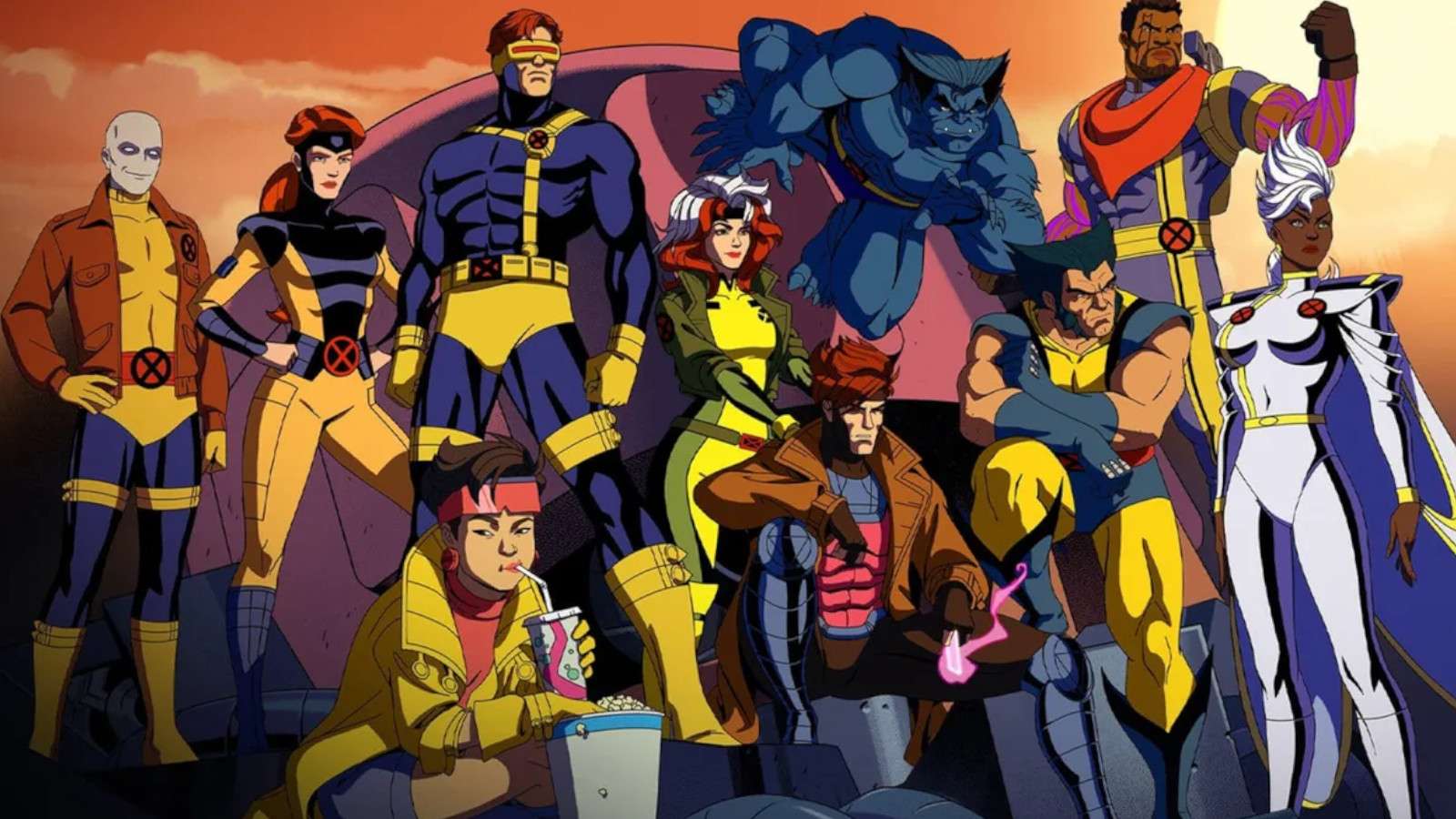 Marvel Studios
Marvel StudiosFrom classic storylines, classic characters, and nods to iconic cover art, here’s our rundown of the best Marvel Comics Easter eggs in X-Men ’97.
Half the fun of X-Men ‘97 is all the nods. The series has so far been filled with many nods to the original series and the comics it is based on. Many of these are pretty obvious, especially if you read a few X-Men comics in the ‘90s. But some of these nods are incredibly obscure, with references to forgotten X-Men and classic stories.
If you’re looking to get up to date, here’s every Easter egg to the comics, movies, and original animated series featured in X-Men ‘97, including references to classic comics, every character Morph transforms into and nods to iconic cover art that we could find.
Contents
- X-Men ’97 Episode 1 To Me, My X-Men Easter eggs
- X-Men ’97 Episode 2 Mutant Liberation Begins Easter eggs
- X-Men ’97 Episode 3 Fire Made Flesh Easter eggs
- X-Men ’97 Episode 4 Motendo/Lifedeath Part 1 Easter eggs
- X-Men ’97 Episode 5 Remember It Easter eggs
- X-Men ’97 Episode 6 Lifedeath Part 2 Easter eggs
- X-Men ’97 Episode 7 Bright Eyes Easter eggs
- X-Men 97 Episode 8 Tolerance is Extinction Part 1 Easter eggs
- X-Men 97 Episode 9 Tolerance is Extinction Part 2 Easter eggs
- X-Men 97 Episode 10 Tolerance is Extinction Part 3 Easter eggs
X-Men ’97 Episode 1 To Me, My X-Men Easter eggs
- The credits are a riff on the original but with some updates. The order is shifted, and character designs are updated. Morph and Bishop are also added to the line-up, along with a new interstitial of Morph running from Mr. Sinister.
- The wanted poster seen at the beginning features Marrow, an X-Men character who was coming into prominence just as the original animated series was ending its run. She’s a Morlock whose mutant power involves bones that grow uncontrollably and can be used as weapons.
- Storm’s mohawk has become as iconic as her, debuting as a look in the ‘80s. Today, it typically shows back up to highlight when she’s less in a goddess mentality and more rebellious.
- Cyclops yet again feigns defeat in the most ‘90s way possible, shouting, “I surrender…NOT!” at his captors in a nod to the original X-Men: The Animated Series pilot.
- The newspaper has a headline asking if Spider-Man is a mutant. Spidey’s a friend to the X-Men in the comics, but his powers came from the spider bite, not the X-Gene, so he’s officially a mutate, not a mutant.
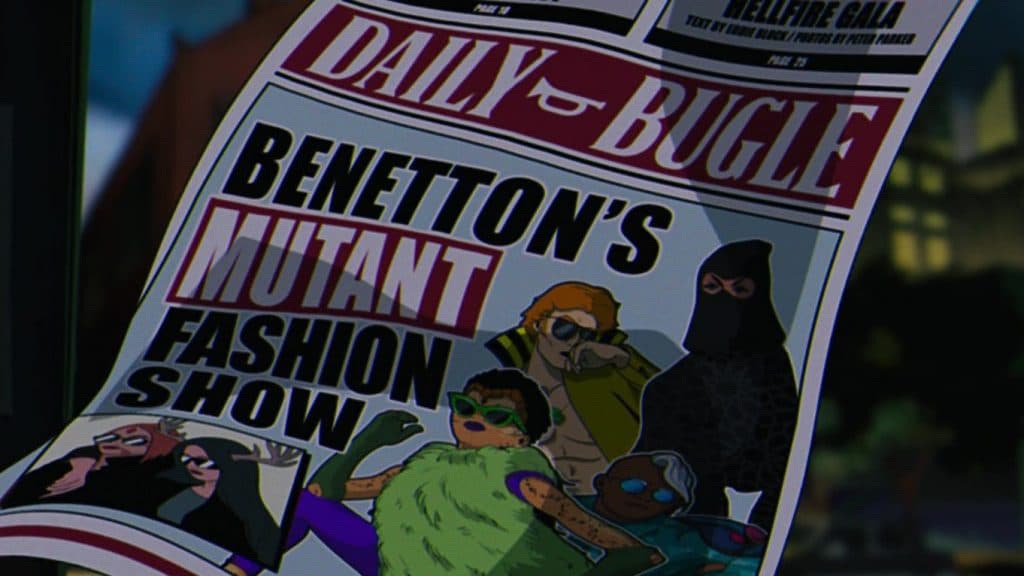 The existence of the Hellfire Gala is teased in a newspaper clipping.
The existence of the Hellfire Gala is teased in a newspaper clipping.- Morph shapeshifts into a walking Xavier, which no one really bats an eye at. In the comics, Xavier often regains the ability to walk, though he does find himself back in the wheelchair in most cases.
- Rogue’s more casual attire is a nod to her ‘80s uniform.
- The paper also references the Hellfire Gala, an annual ball where the X-Men elect their new Krakoa representatives. It also advertises a mutant fashion show, which appears to feature Banshee, Dust, and Maggott, among others.
- Jubilee asks Sunspot if he can “shoot gold balls from your body.” This is a nod to Gold Balls, a member of Cyclops’ Uncanny X-Men following Avengers vs. X-Men. In the modern era, he’s taken on the name Egg, as his gold balls are used to create the eggs for mutant rebirth.
- There’s a portrait of the original five X-Men in their training uniforms hanging up in Xavier’s office. The timeline is a little different for X-Men ‘97, with Cyclops and Jean being the first two X-Men, followed by Beast, Iceman, and Angel. In the comics, Jean was the last addition to the team.
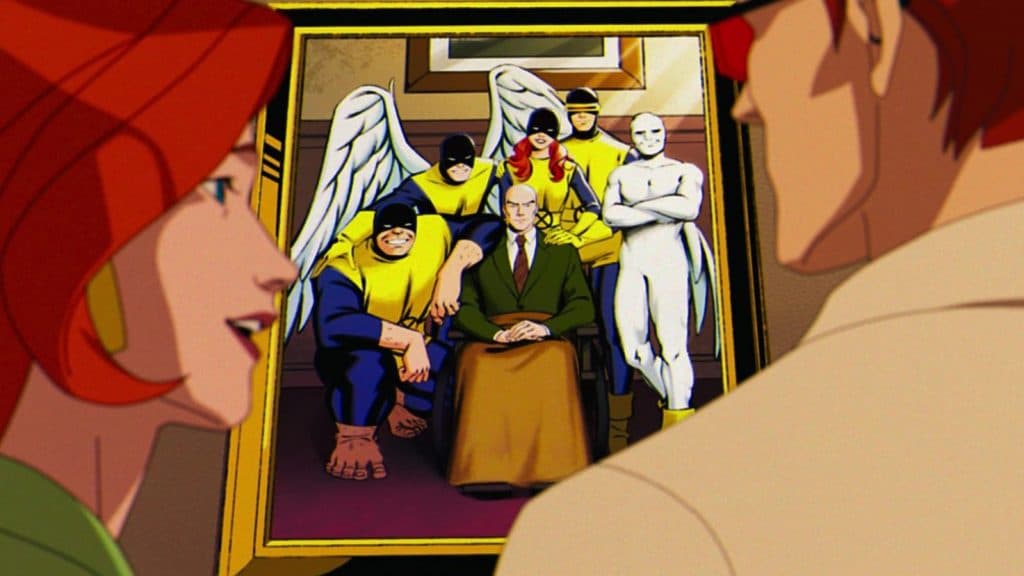 A portrait in Xavier’s office shows the original X-Men in their first uniforms.
A portrait in Xavier’s office shows the original X-Men in their first uniforms.- In the bar, Morph shapeshifts into his original form. For X-Men ‘97, Morph’s appearance was redesigned to match his comic version.
- Morph shapeshifts into Archangel. Angel was an original member of the X-Men, but Apocalypse corrupted him into his Horsemen of Death, which gave him blue skin and razor-sharp wings.
- “To me, my X-Men!” is presented as a de facto X-Men call to action, but it’s a fairly recent attempt to give the team a catchphrase. While it’s existed in some form since the original X-Men #1, the specific phrasing didn’t come into prominence until the ‘90s.
- Morph shapeshifts into the Blob, a member of the Brotherhood of Evil Mutants who is resistant to physical forces and cannot be moved.
- Cyclops attempts to retire from the X-Men to raise his son with Jean Grey. In the comics, Cyclops has left the X-Men on a few occasions but did specifically leave at one point to raise his son, Nathan, with then-wife Madelyne Pryor. He returned to the fold as a member of X-Factor when Jean was found alive.
- The concept of the Last Will & Testament of Charles Xavier causing havoc for the X-Men stems from a story of the same name. In that story, the school is left to Scott, who, at this point, was an outcast after being responsible for Xavier’s death in Avengers vs. X-Men.
X-Men ’97 Episode 2 Mutant Liberation Begins Easter eggs
- Setting a standard for the series, the title sequence is updated to reflect the roster. Professor Xavier’s card is removed, and Magneto is positioned as the leader. New scenes of Magneto on Asteroid M and Storm fighting Callisto are added.
- We see the Morlocks, specifically Callisto and Leech. They’re recurring characters from both the comics and X-Men: The Animated Series, a race of mutants who live in the sewers. Storm is occasionally considered their leader because she beat Callisto in a duel, but Callisto leads them in her absence.
- We see Magneto’s new costume, a sleeveless purple number with a giant M emblazoned on it. He wears a similar get-up in the ‘80s when he reforms and becomes the X-Men’s leader.
- Magneto has reformed Genosha into a mutant safe haven. In the comics, it is often a mutant refuge, at one point being given to Magneto by the UN to form a nation of mutants. In the modern era, Genosha is all but a desolate ruin, having been destroyed by Sentinels by order of Cassandra Nova.
- While Jean and Storm are packing, Jean is seen holding her classic Marvel Girl costume. She’s returned to this look on more than a few occasions, such as when she fought for her life against the Shi’ar in The Dark Phoenix Saga and the early Krakoan Age stories.
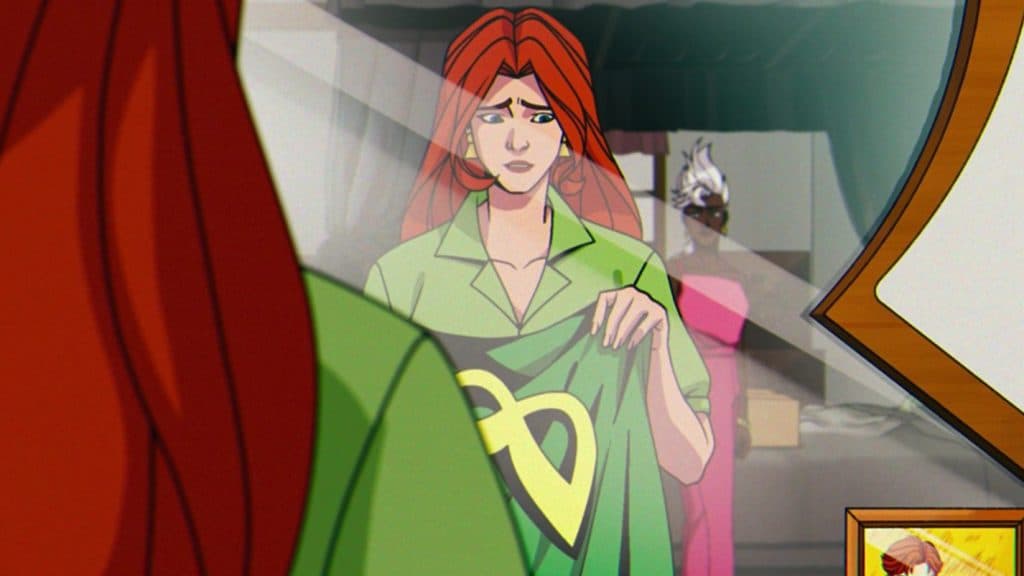 Jean is shown packing her classic Marvel Girl costume.
Jean is shown packing her classic Marvel Girl costume.- Magneto reveals his helmet is designed to block Charles’ telepathy. This is a retcon in line with the comics, which introduced a similar function after the success of the first X-Men film. Originally, Magneto’s helmet did allow him some control over human minds, but it didn’t block telepathy until the movies did it.
- Rogue and Magneto’s relationship is hinted at here. The two have a controversial pairing that only lasts a few months but does result in Magneto proposing marriage. Rogue eventually marries Gambit in the Krakoan Age.
- The bulk of this episode is based on Uncanny X-Men #200’s The Trial of Magneto. The comic also sees Magneto on trial for his crimes against humanity, where he single-handedly saves both the Judge and Xavier from an attack during the trial. Much like in The Animated Series, Xavier is taken away by Lilandra for medical treatment, with Magneto taking charge of the X-Men.
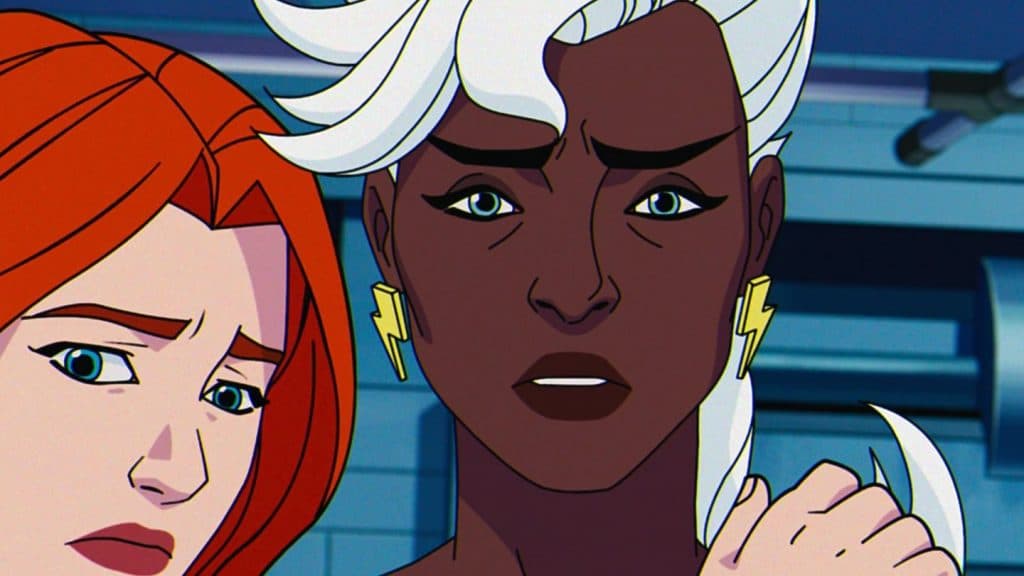 Storm losing her powers was the basis of an important years-long arc for the character.
Storm losing her powers was the basis of an important years-long arc for the character.- Storm losing her powers to a gun designed to neutralize mutants comes from Uncanny X-Men #185. In the comic, Henry Peter Gyrich tries to neutralize a rampaging Rogue’s powers, but Storm is accidentally shot instead.
- X-Cutioner is used here as a figurehead for the Friends of Humanity. In the comics, he works independently of any team, though his goal of mutant eradication is the same.
- Scott and Jean name their son Nathan Charles Summers after the late Xavier. In the comics, he’s Nathan Christopher Charles Summers, having also been named after Cyclops’ father, Christopher Summers/Corsair.
- Morph shapeshifts into Sabretooth in an attempt to cheer up Wolverine.
X-Men ’97 Episode 3 Fire Made Flesh Easter eggs
- Following the trend of changing the intro, the de-powered Storm is no longer present. Additional scenes of Magneto fighting the X-Men and Jean as the Dark Phoenix have been added.
- There’s also a shot of Sunspot running into a fence while being chased by Sentinels. A similar scene happens in the original series’ intro, but with Jubilee.
- In the comics, Scott was not tricked into having a child with a clone of Jean. Instead, he married Madelyne Pryor, a woman who looked remarkably like Jean and started a family with her. He left Madelyne after Jean was resurrected.
- There are a lot of flashbacks to The Animated Series seen here in Jean’s memories, including Jean and Scott being saved from the Morlocks and Jean becoming The Dark Phoenix.
- Morph shapeshifts into Spyral, a six-armed mutant who lives in Mojoverse.
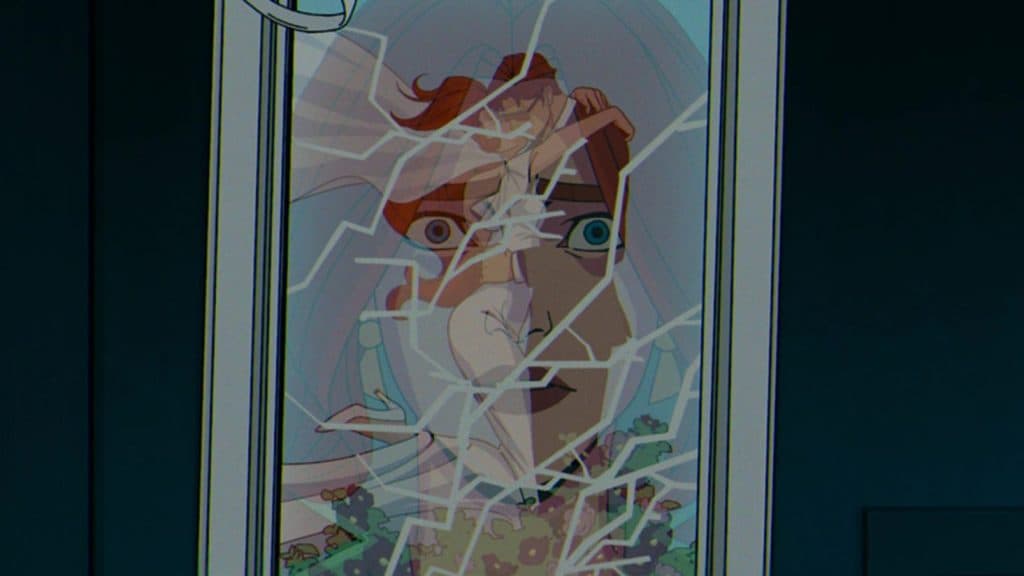 Cyclops and Jean Grey’s wedding photo is a recreation of a classic comic book cover.
Cyclops and Jean Grey’s wedding photo is a recreation of a classic comic book cover.- Scott and Jean’s wedding photo is a direct reference to the cover of X-Men #30, the issue in which they were finally married.
- The clone of Jean references her actions as “an inferno” and takes on the name Goblin Queen. This is a nod to the 1989 storyline Inferno, where Madelyne bargains with demons from Limbo to find Nathan. In the process, she learns that she is a clone of Jean, then allies with Limbo and becomes the Goblin Queen.
- In the visions, Bishop sees his sister, Shard. Shard is a mutant in the future who can turn light into concussive force blasts.
- When Gambit spies Magneto and Rogue, it resembles the cover of Uncanny X-Men #274. The story saw Magneto and Rogue stranded in the Savage Land and nearly forming a romantic relationship, but Rogue left after witnessing Magneto kill again.
- When talking about Sinister, Morph shifts into a more dour face with bags under its eyes. This is the look Morph had after Sinister revived him and brainwashed him.
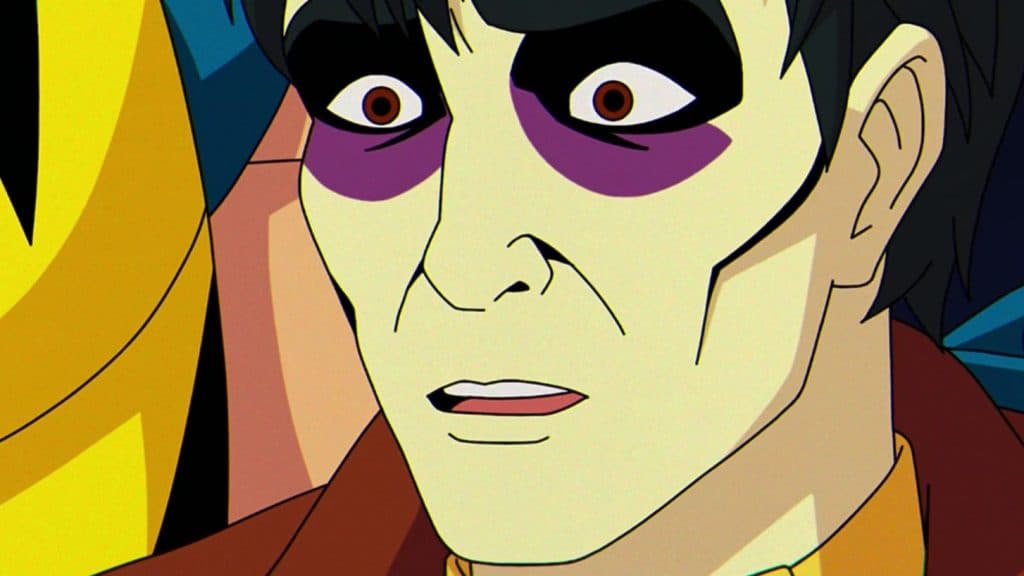 Morph briefly reverts to his evil face from Season 2
Morph briefly reverts to his evil face from Season 2- Sinister’s hint at Nathan’s destiny may be an allusion to his fate as one of The Twelve. Nathan is destined to fight Apocalypse in one possible future.
- Morph shifts into Illyana Rasputin/Magik, the sister of Colossus, as well as her Darkchylde form. Illyana is a half-demon and bearer of the Soulsword who factored heavily in the original Inferno. Today, she’s often considered the ruler of Limbo and serves as Cyclops’ war general on the X-Men.
- Jean’s retcon origin is referenced. Originally Jean only had low-level telekinesis, but a retcon established her as a powerful telepath, with Xavier making mental safeguards so her power wouldn’t overwhelm her.
- Nathan is ravaged by a techno-organic virus and sent into the future for help. In the comics, Nathan is raised in the future and trained to use his telekinesis to keep the virus in check. He becomes Cable, a soldier from the future who is sent back in time to help fight Apocalypse, eventually forming the mutant paramilitary team X-Force.
- Scott stresses he won’t abandon his son like his father did him. He’s referring to the space pirate Corsair. In Cyclops’ origin, he’s thrown by his parents from a crashing plane to save him. In fact, Scott’s parents are abducted, with his mother being killed shortly after and his father becoming a spacefaring pirate.
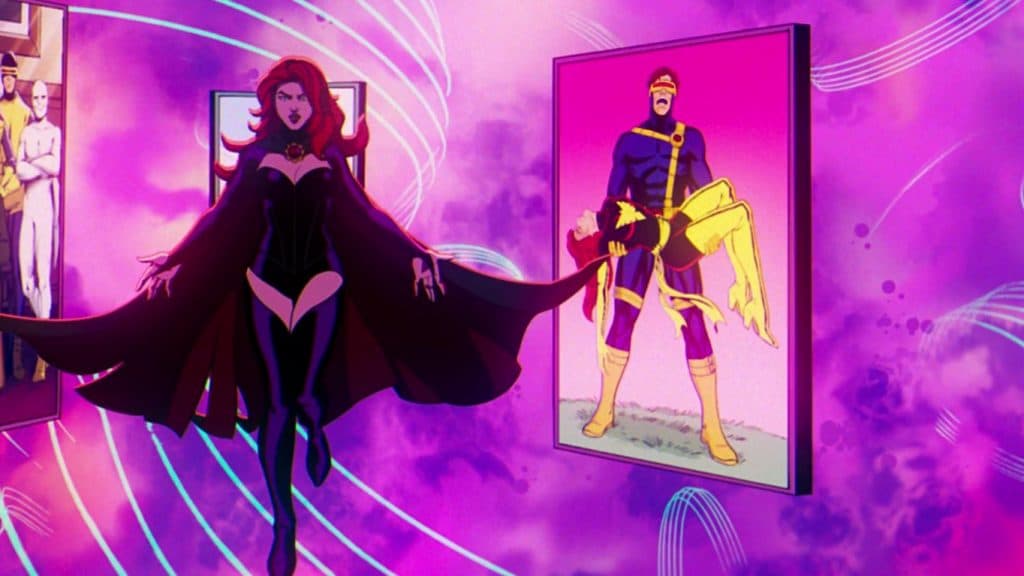 The image of Scott cradling Dark Phoenix is one of the most referenced covers in comics.
The image of Scott cradling Dark Phoenix is one of the most referenced covers in comics.- The image of Scott holding a dead Phoenix from Uncanny X-Men #136 is featured in Jean’s visions. It’s become an incredibly iconic comic book image and is considered one of the most referenced covers in comics.
- Jean’s clone takes on the name Madelyne Pryor, the name she believed was her real name in the comics. Madelyne being a clone of Jean in the comics is actually a massive retcon. The original plan was for Jean to stay dead, with Cyclops marrying Madelyne and retiring from superheroics. The decision to create X-Factor, a new title that started the original X-Men, changed this. Madelyne was later retconned into being a clone of Jean designed to manipulate him.
- Storm is wearing her black leather outfit at the episode’s end. Storm first rocks the look, along with her mohawk, in Uncanny X-Men #173, changing up her appearance after spending a night on the run with the thief Yukio in Japan. These days, it’s more commonly associated with her time in Dracula’s thrall thanks to the character Bloodstorm.
- Storm meets Forge, who promises to help her get her powers back. Forge has the mutant ability to build anything. In the comics, he designed the gun that took away Storm’s powers but regretted its use.
X-Men ’97 Episode 4 Motendo/Lifedeath Easter eggs
- The intro is updated to include shots of Jubilee and Longshot fighting Mojo, Forge with X-Factor, and Xavier confronting the Hellfire Club.
- Magneto references his parents dying when he was a child. In his comics origin, they were killed shortly after the German Invasion of Poland. Magneto, the sole survivor of his family, was imprisoned in Auschwitz afterward.
- Genosha entering the UN is brought up. In the comics, Genosha was briefly given to Magneto to form a mutant nation as a gesture of goodwill. It was destroyed by Cassandra Nova.
- Jubilee has a Longshot doll in her room, his only appearance in this episode outside of the intro. Longshot is a Mojoverse mutant and freedom fighter with the ability to manipulate luck. He last appeared in X-Men: The Animated Series 3.10, Longshot. In that episode, both Longshot and Mojo escape into the real world and are sent back with help from Wolverine, Rogue, and Jubilee.
- The Motendo console and logo are modeled after a Model 1 Sega Genesis.
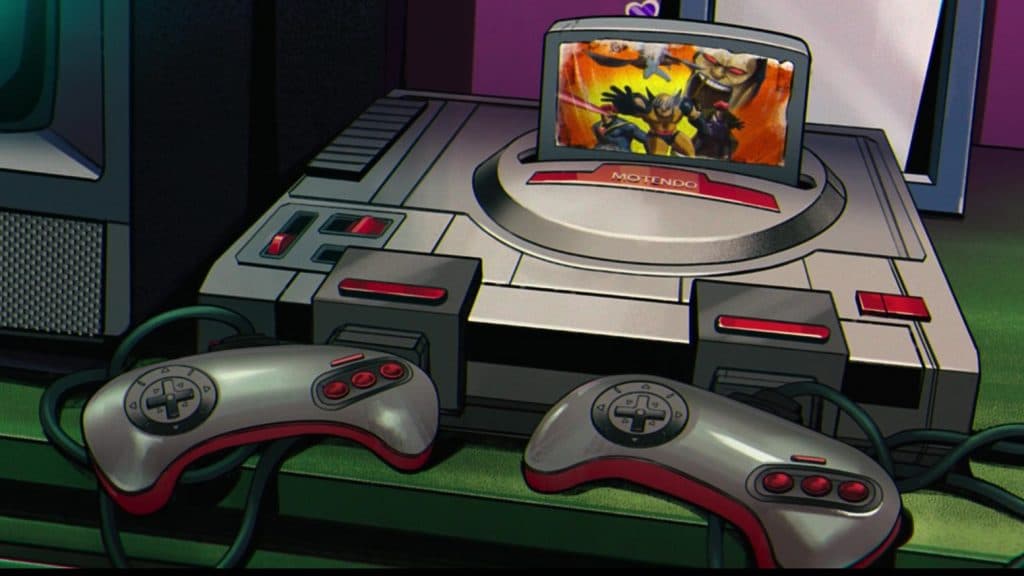 The Motendo console is inspired by the original Model 1 Sega Genesis.
The Motendo console is inspired by the original Model 1 Sega Genesis.- The art for the Motendo cartridge is based on 1993’s X-Men, developed by Western Technologies and published by Sega. Today, it’s mostly remembered for its Mojoverse level, which required players to physically restart their consoles in order to proceed.
- The episode contains many allusions to The Matrix, including the dial-up sound when Jubilee and Roberto are transported into the game, using a landline phone to exit the world, and the concept of a rogue program upsetting the balance of the world. Mojo’s comment that “if you die in the game, you die in real life” also echoes Morpheus’ warning to Neo.
- Roberto refuses to use his powers because his family might see them. In the comics, Roberto’s father, Emmanuel Da Costa, is a member of the Hellfire Club.
- Jubilee and Roberto find themselves on Genosha from “way back when.” Her comments reference X-Men: The Animated Series 1.07, Slave Island, where she’s imprisoned on Genosha with Storm and Gambit. We also see Sunspot, The Blob, and Domino again as prisoners on Genosha.
- We only see a hint of his costume, but Thunderbird appears in the Genosha flashback, referencing his cameo in the original episode. Because the credits were being animated while that episode was in production, Thunderbird was mistakenly included in Magneto’s Brotherhood of Evil Mutants to fill a gap in the line-up.
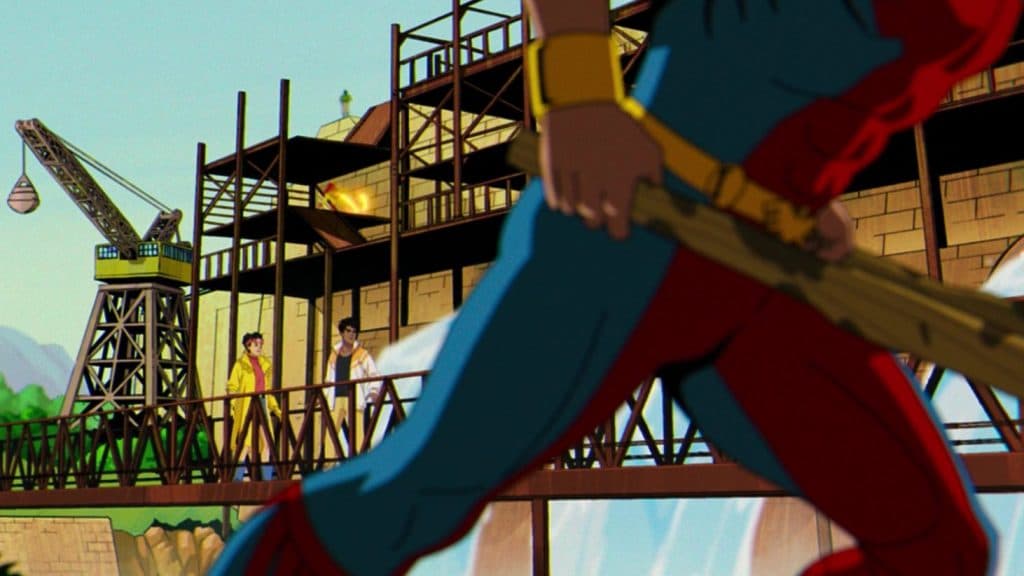 Thunderbird returns for a cameo, referencing his appearance as a slave on Genosha.
Thunderbird returns for a cameo, referencing his appearance as a slave on Genosha.- Storm, Jean Grey, Professor X, Magneto, and Cyclops are all featured in the “Who’s the Boss?” graphic. All five characters have led the X-Men, occasionally fighting each other for the right.
- Darwin, Northstar, and Forge feature on the “A Different World” graphic. This would mark Darwin’s animated debut, as he wasn’t created until the Deadly Genesis event.
- The crux of this episode–the Motendo game starring Jubilee–is a send-up of classic Konami arcade beat-em-ups, including Teenage Mutant Ninja Turtles: Turtles in Time and, of course, 1992’s X-Men, which used character designs based on the previous animated series pilot, Pryde of the X-Men.
- The poster of mutants in the background of the first stage is a direct homage to the Uncanny X-Men #141 cover art. In the story, Days of Future Past Part 1, various mutants on the poster are marked as having been captured or slain.
- The boss of the Savage Land stage is Sauron. In the comics, Karl Lykos is an unassuming scientist with a need to feed on life energy. Taking too much mutates him into Sauron, a human/pterodactyl hybrid with hypnosis powers who seeks to destroy the world.
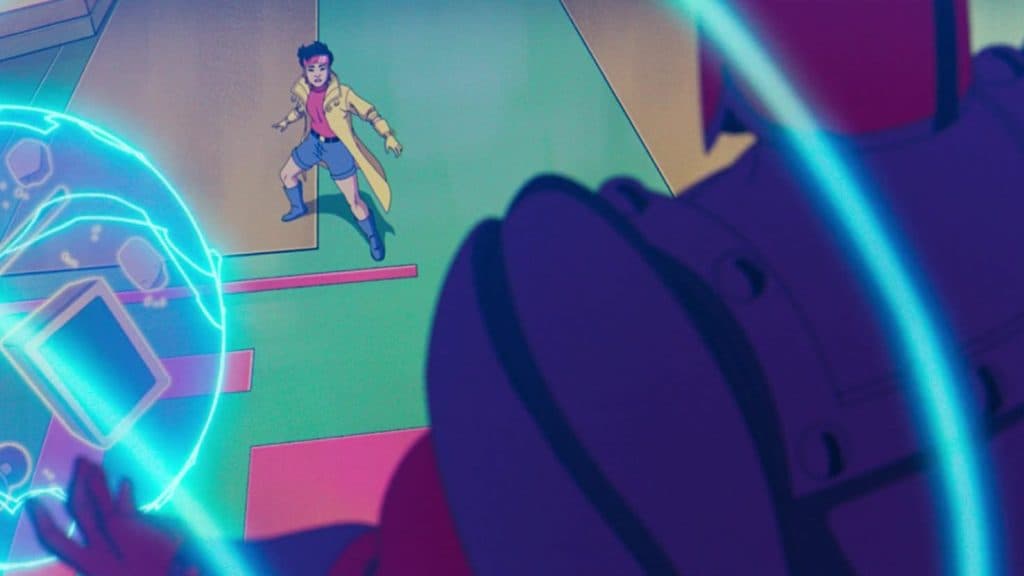 Jubilee fights Magneto on his space hideout, Asteroid M.
Jubilee fights Magneto on his space hideout, Asteroid M. - The final stage is on Asteroid M. In early X-Men stories, Magneto lived in a base called Asteroid M, which, in fact, referred to any of the multiple bases he built in space over the years.
- The arcade cabinet Mojo breaks out of is based on the six-player X-Men arcade game cabinet by Konami.
- The second half of the episode, Lifedeath – Part 1, is based on a similar story from Uncanny X-Men #186. In the original story, Storm is missing after having been shot by Henry Peter Gyrich; unbeknownst to the X-Men, she has lost her powers and is being nursed back to health by Forge. The scene of the two sharing a meal and discussing Forge’s past closely resembles a similar scene from the comic.
- Forge says he lost his leg and hand in “the war.” In the comics, Forge was a Vietnam War veteran and Cheyenne medicine man. He summoned demons to avenge his fallen comrades in a fit of anger. Having a change of heart, he tried to bomb the portal the demons were coming from, losing his arm and leg in the process.
- We see an image of Forge with X-Factor–Quicksilver, Havok, Polaris, Strong Guy, Wolfsbane, and Madrox the Multiple Man. This incarnation of the team appeared in X-Men: The Animated Series 3.11, Cold Comfort. Storm was absent from that episode, so it makes sense she doesn’t know Forge.
- Storm looks noticeably uncomfortable in Forge’s machine. In both the comics and animated series, Storm suffers from claustrophobia after being trapped under rubble as a child.
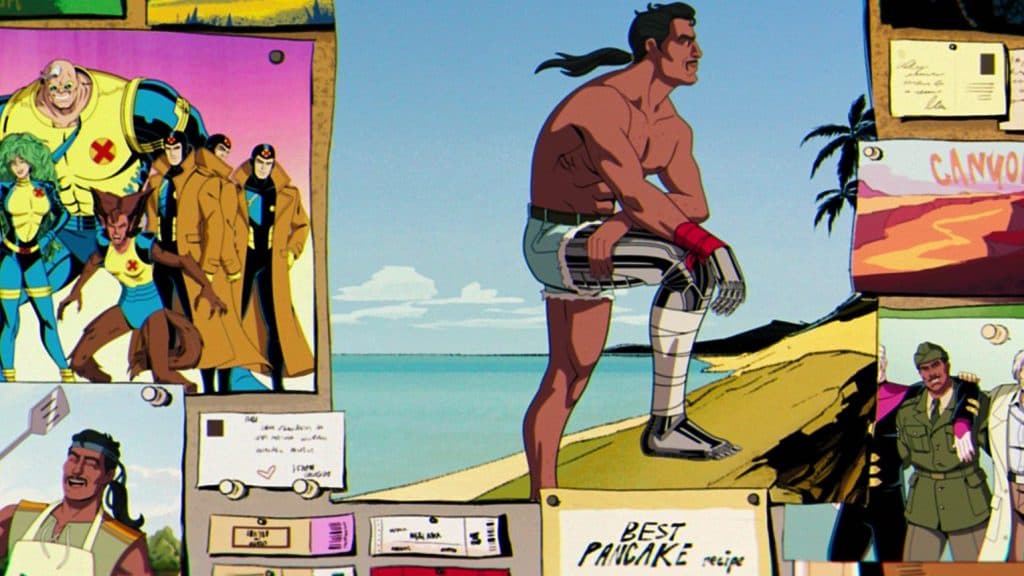 Forge’s photos show him with X-Factor and tease a connection to Bastion.
Forge’s photos show him with X-Factor and tease a connection to Bastion. - There’s another photo of Forge with Gottfried Adler and a man in a black and purple costume. The costume is a match for Bastion, a prominent X-Men villain from the ‘90s. Bastion is an android based on the designs of Master Mold and Nimrod. He uses the fear following the Onslaught event to convince the government to enact the anti-mutant program Operation: Zero Tolerance.
- Forge reveals his designs were used to build the Mutant Inhibitor Collars. In the comics, Forge actually designed the gun that rendered Storm powerless, a fact she only found out by accident rather than him confessing.
- The Scottish scientist is likely Gottfried Adler, who was said to have developed Genosha’s Inhibitor Collars in X-Men: The Animated Series 1.09, The Cure (though Adler in that episode is actually Mystique in disguise).
- Storm falls through the floor in Forge’s house before the two are chased by a demon for the episode’s cliffhanger. In the original comic, Storm accidentally sets off the high-tech holograms Forge has built into his house, which makes her relive the incident where he lost his limbs in the war.
X-Men ’97 Episode 5 Remember It Easter eggs
- The intro is updated to include a scene of Cable running from Apocalypse and Gambit and Nightcrawler fighting.
- Trish Tilby is a minor character from the comics who debuted while investigating X-Factor. She briefly begins a relationship with Beast that falls apart during New X-Men when he further evolves into a more feline form.
- Leech of the Morlocks returns. He’s a unique character with the mutant power to suppress other X-genes. In this episode, he’s often seen with two mainstay X-Men: Pixie/Megan Gwynn, who can teleport and fly, and Glob/Robert Herman, whose body is made of living wax.
- The X-Men character who can make ice cream may be a sly Iceman cameo, but they do also call to mind Soft Serve, a mutant on Krakoa whose excrement was ice cream.
- The mutant with antlers is Nature Girl/Lin Li, who joined the Jean Grey Institute during Wolverine’s tenure as Headmaster.
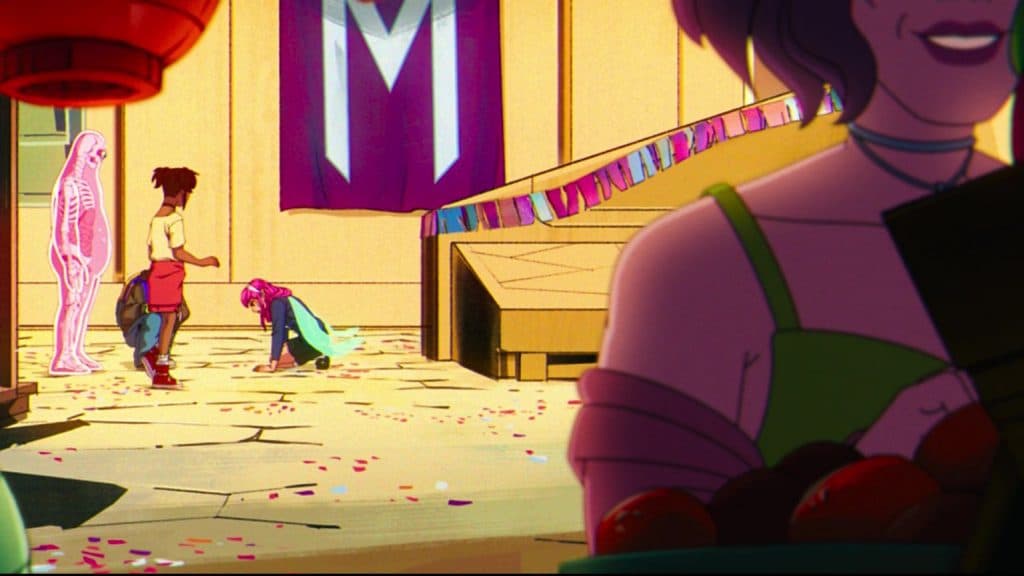 There’s a number of surprise cameos on Genosha, including Blink, Nature Girl, Pixie, and Glob.
There’s a number of surprise cameos on Genosha, including Blink, Nature Girl, Pixie, and Glob.- Though we don’t see much of her, the girl with purple skin and a green shirt seems to be Blink, a fan-favorite mutant from Age of Apocalypse. She can throw energy daggers that create portals.
- Genosha doesn’t typically have a statue of Magneto and Xavier, though a memorial to him was raised at some point following Genosha’s destruction.
- Nightcrawler makes his return and is mentioned to be working with Genosha’s communities of faith. In the original series, he was raised by monks. In the comics, Nightcrawler is devoutly Catholic and moonlights as a priest. During the Age of Krakoa, he briefly attempted to start a new mutant religion.
- The dancers in the town square consist of Jamie Madrox/Multiple Man, who can create and reabsorb duplicates of himself; Exodus/Benet du Paris, who has telekinetic and telepathic powers that are enhanced when others have faith in him; Dazzler, who can convert sound into light blasts.
- Rogue is greeted by Boom-Boom/Tabitha Smith, an X-Force member who can create explosive orbs.
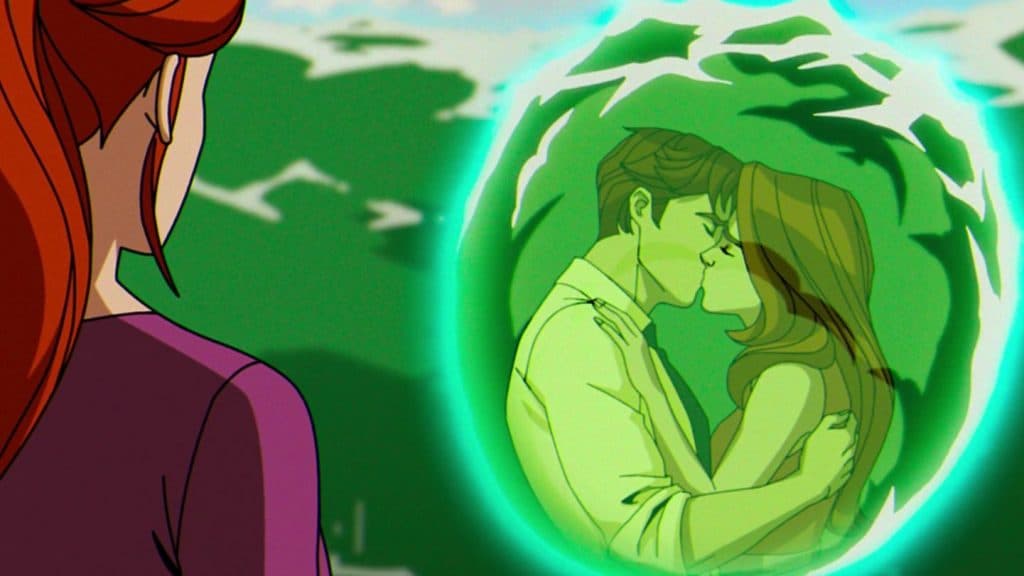 Jean and Scott’s story about their picnic references a key comic book moment.
Jean and Scott’s story about their picnic references a key comic book moment. - Jean and Scott’s story about a picnic where she held back his powers with hers references a story that took place in Uncanny X-Men #132.
- Magneto becoming the leader of Genosha took place several times in the comics, with him first being gifted the island by the UN.
- Moira MacTaggart and Sean Cassidy/Banshee are members of the council. Moira is Xavier’s former lover, while Banshee is a former Interpol agent who can generate sonic screams. He joined the X-Men in Giant-Size X-Men #1.
- Hellfire Club members White Queen and Sebastian Shaw return to the show. They last appeared in the original series’ adaption of Dark Phoenix Saga.
- The psychic affair between Scott and Madelyne is reminiscent of Scott’s affair with White Queen during New X-Men. Scott and Emma were a couple for years following the affair, though he eventually reconnected with Jean.
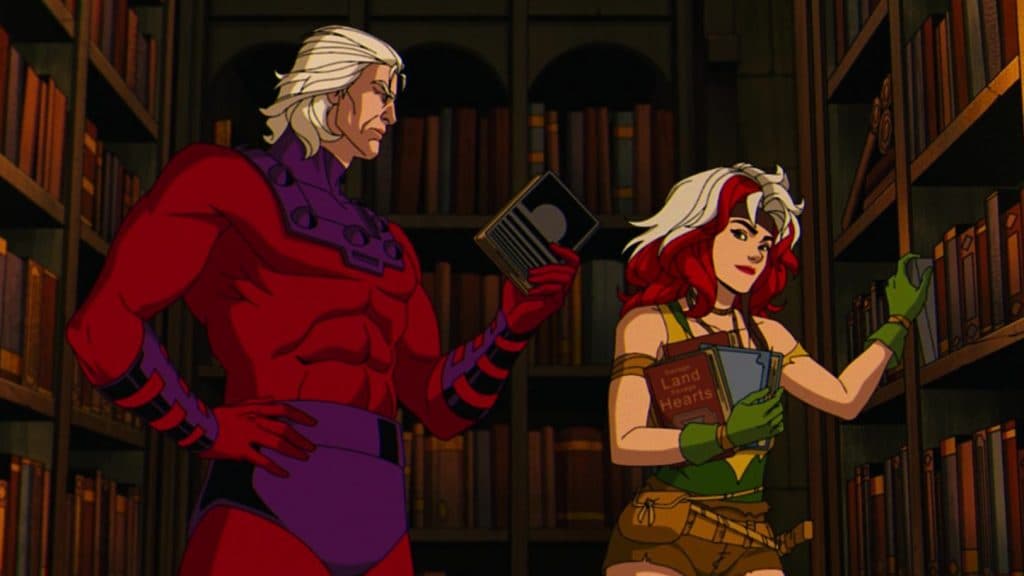 Rogue and Magneto’s time in the Savage Land is pulled straight from the comics.
Rogue and Magneto’s time in the Savage Land is pulled straight from the comics.- Rogue’s backstory and the costume she wears here are from an Uncanny X-Men story where she was stranded in the Savage Land and first kindled a relationship with Magneto.
- The Watcher is visible in the stars above the party. In the comics, the Watcher is sworn never to interfere but may make himself seen before a great event is about to occur.
- Among the mutants seen when Cable enters the party is Marrow, a mutant who can grow and break off bones.
- The Genosha Holocaust happened in the first arc of Grant Morrison’s New X-Men run. The original was spearheaded by Cassandra Nova, an energy deity who had taken on many elements of Xavier’s life.
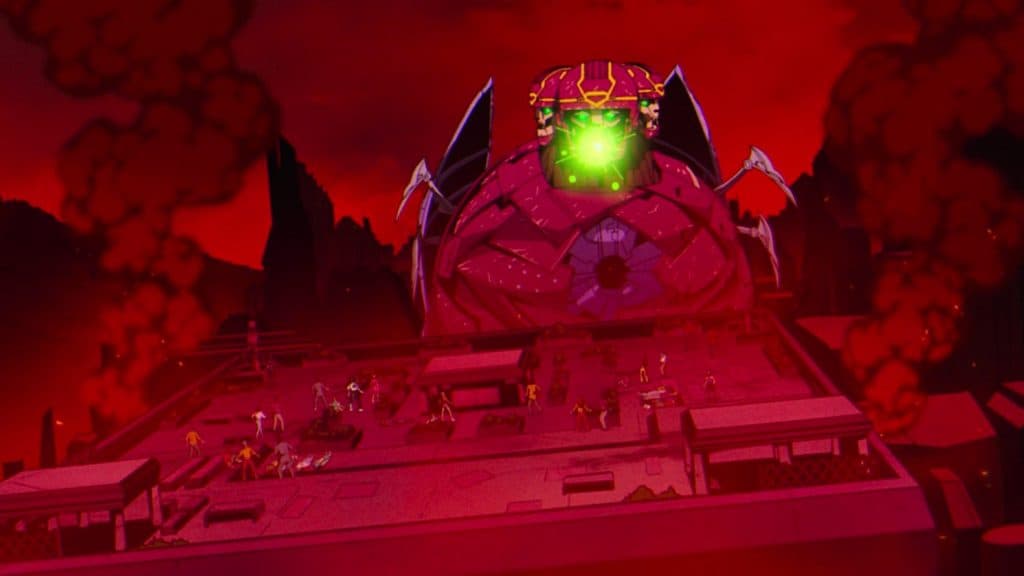 Disney+
Disney+- The massive Sentinel matches the design of the Wild Sentinel, a design created by Cassandra Nova and Donald Trask. Nova forced Trask to design it, then used it to attack Genosha.
- Magneto flashes back to his childhood in a concentration camp. Though X-Men ‘97 and the original series have never come out and said it, Magneto is a survivor of the Nazi holocaust, having been orphaned and imprisoned in Auschwitz.
- A death toll is never mentioned, but the number of mutants killed in the Genosha attack in the comics is said to be 16 million.
- Gambit’s death is unusual, as he’s one of the few X-Men to never actually die and be revived. However, he was briefly Death, the Horseman of Apocalypse in the comics. Considering Cable’s cameo seems to hint at Apocalypse’s return, could this be setting up Gambit as a horseman?
X-Men ’97 Episode 6 Lifedeath Parth 2 Easter eggs
- Following last week’s massacre, Magneto and Gambit are removed from the intro. Nightcrawler is now shown as a member of the team. The shot of the team running to the left also removes Gambit and adds Nightcrawler.
- New sequences of Nimrod inside Master Mold, the X-Men fighting the Shi’ar Imperial Guard, and Xavier and Lilandra are added.
- Among the soldiers fighting with Deathbird is Vulcan. Debuting in Deadly Genesis, Vulcan is the long-rumored third Summers brother. He eventually joins the second team of X-Men, but is believed to have died for decades before returning following House of M. A later story, War of Kings, sees him assume command of the Shi’ar empire.
- Xavier and Lilandra announce their intent to wed here. In the original comics, the two form an unusual bond when Lilandra flees to Earth accused of treason against the empire. In Uncanny X-Men #117, believing the X-Men died fighting Magneto, he leaves with Lilandra and lives for a time as her consort with the Shi’ar.
- Xavier’s gold armor is from Uncanny X-Men #275 and is a suit of armor he wore while disguised as The Warlord to deceive Deathbird.
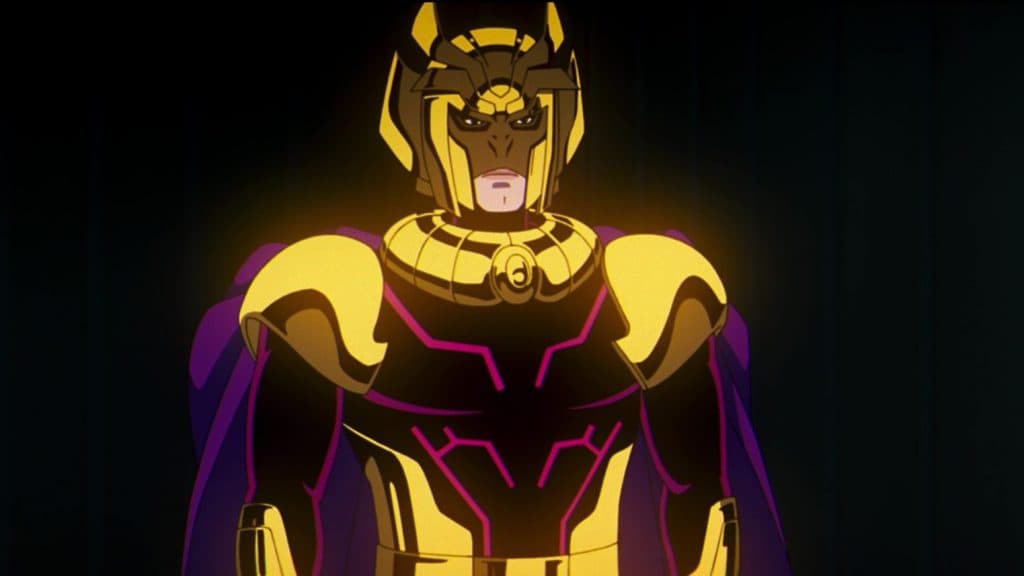 Xavier gets slick Shi’ar Battle Armor in X-Men ’97.
Xavier gets slick Shi’ar Battle Armor in X-Men ’97. - The demon Storm fights to save Forge is The Adversary. In Forge’s backstory, he summoned The Adversary to avenge fallen soldiers but tried to send it back when he realized what he had done. Trying to do so is how he lost his arm and leg.
- Storm trying to save Forge may be an homage to one of the final comic stories where she was powerless. In it, Adversary tricks her into believing Forge is going to summon more demons, and she stabs him, thinking she’ll save the world. Forge was, in fact, trying to close the portal.
- It’s revealed that Storm’s powers returned, and a mental block was stopping her from accessing them. It’s similar to how she got her powers back in Uncanny X-Men #226, though the events happened across only a few panels. Forge, firing a blaster that restored Storm’s mutant genes, briefly cannot access her powers but soon regains them.
- Storm debuts a new black and gold costume after getting her powers back. The look is her original comics costume, which she wore starting in Giant-Size X-Men #1.
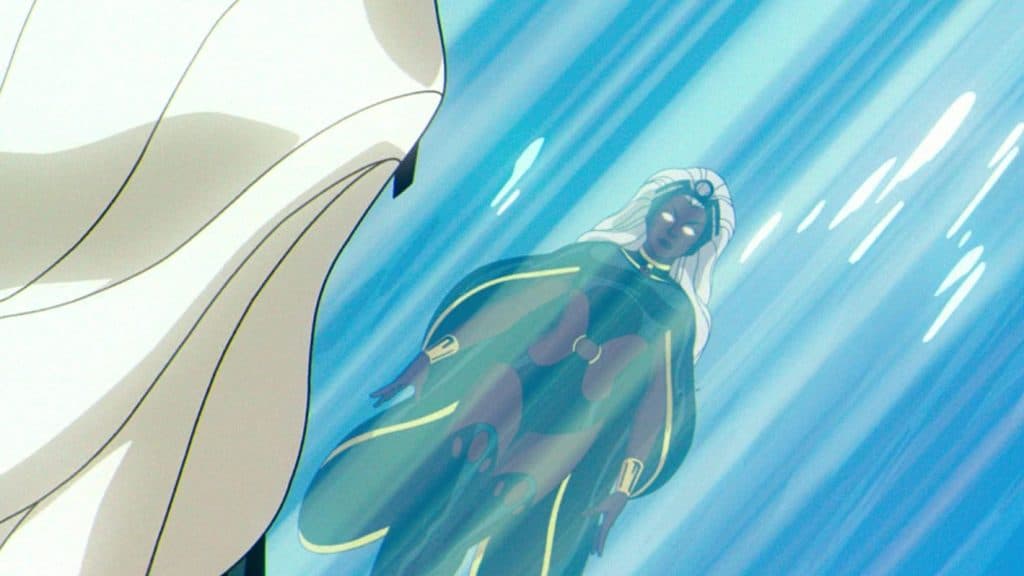 Storm’s classic costume makes its X-Men ’97 debut.
Storm’s classic costume makes its X-Men ’97 debut. - It’s revealed Bolivar Trask gave Mr. Sinister his DNA so he could use Master Mold to make the Wild Sentinel that destroyed Genosha. In the comics, it was Bolivar’s nephew, Donald, whose DNA was stolen by Cassandra Nova for a similar purpose, though Nova killed Donald afterward.
X-Men ’97 Episode 7 Bright Eyes Easter eggs
- Gambit’s brother, Bobby, and ex-wife, Bella Donna, appear alongside members of the Thieves Guild at his funeral. They were last seen in the X-Men: The Animated Series episode X-Ternally Yours.
- Nightcrawler officiates Gambit’s funeral. In the comics, Kurt is fiercely religious and a respected Catholic priest.
- President Kelly makes overt mentions of politicians who may be less favorable to mutants. Prior to the Operation: Zero Tolerance event, the assassination of Presidential candidate Graydon Creed, who campaigned on anti-mutant platforms, opened the path for Bastion to enact his plan. Creed, who is the powerless son of Sabretooth and Mystique, previously appeared in X-Men: The Animated Series as the leader of Friends of Humanity.
- The facility Rogue attacks is overseen by General Thaddeus “Thunderbolt” Ross, a longtime Hulk foe and, in many stories, Bruce Banner’s father-in-law.
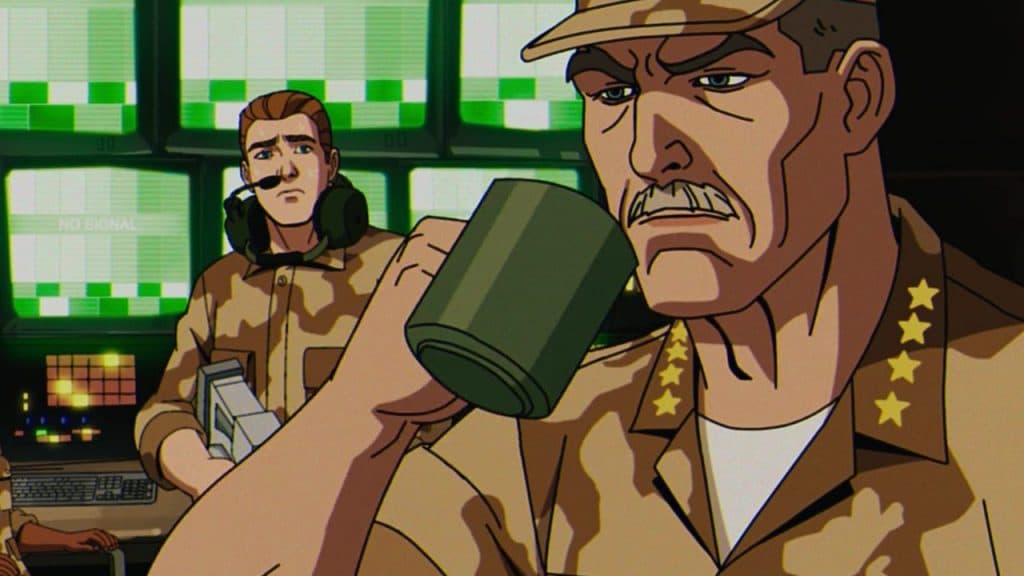 Hulk foe Thunderbolt Ross makes his X-Men ’97 debut.
Hulk foe Thunderbolt Ross makes his X-Men ’97 debut. - Amelia is a mutant who can turn both herself and any matter within her vision into a mist-like state. In the comics, she’s an old flame of Xavier’s who joined Magneto’s Acolytes.
- There are cameos galore among the Genoshan survivors, including Mimic, Nature Girl, and Strong Guy.
- Beast and Trish’s strained relationship hearkens back to the days of Astonishing X-Men. In those stories, Beast was frustrated as his mutation was progressing and he was, seemingly, devolving into a more bestial state.
- The scene of Emma surviving, thanks to her sudden secondary mutation into a Diamond Form, is ripped straight out of New X-Men #116.
- We meet Sunspot’s mother here. In the comics, she’s a Brazilian archeologist who married a wealthy billionaire. Both she and her husband, Emmanuel, have ties to the Hellfire Club.
- Nightcrawler and Rogue refer to themselves being siblings. Nightcrawler is Mystique’s biological son with the mutant Destiny but was raised in an orphanage. Rogue was adopted by Mystique as a child and raised to be a mutant criminal.
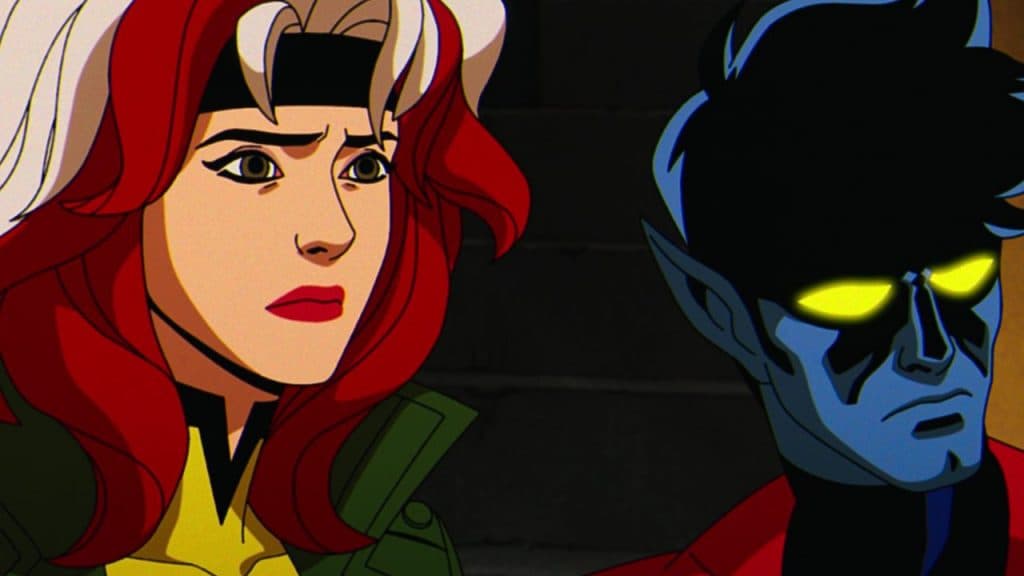 Rogue and Nightcrawler’s often downplayed relationship is front-and-center in Bright Eyes.
Rogue and Nightcrawler’s often downplayed relationship is front-and-center in Bright Eyes. - The X-Men find out about the name of Operation: Zero Tolerance long before learning what it means. A similar thing happened in the comics, with Gambit and Rogue discovering the program while ransacking a government facility but not finding any details.
- Bolivar Trask, remorseful over his actions, attempts to take his own life. His comic counterpart dies in Uncanny X-Men #16 under similar circumstances, sacrificing himself to destroy a Sentinel facility after realizing he was wrong about the X-Men’s motives.
- We see our first Prime Sentinel in Trask’s reanimated corpse. Trask was never a Prime Sentinel in the comics, but it is in line with the comics that the host would not be aware they had been changed.
- Morph shapeshift into Magneto’s son, Quicksilver, and uses super speed against Trask.
- Bastion threatens to expose Xavier’s faked death to the world. A major component of the original Operation: Zero Tolerance was Xavier surrendering himself for his role in the Onslaught event, which led to Bastion taking over the school and torturing Xavier.
X-Men ’97 Episode 8 Tolerance is Extinction Part 1 Easter eggs
- Cable’s vision of the future features a number of mutants who have been enslaved. Notable among them are Magneto’s daughter, Lorna Dane/Polaris, and Scott and Jean’s alternate reality daughter, Rachel Summers/Phoenix.
- Jubilee and Roberto see a program being hosted by William Stryker. Stryker is the antagonist of God Loves, Man Kills, which is hailed as one of the most important X-Men stories ever. Stryker is a religious zealot who killed his wife and son after his son was born a mutant.
- In the original Ultimate X-Men, a version of Stryker’s son survives the Ultimatum wave and declares war on mutants, fueled by his family’s death and his father’s anti-mutant views. This Ultimate version of Stryker has powers that enable him to communicate with and control technology, such as Sentinels, and has a design that closely resembles Bastion.
- Kate’s Coffee could be foreshadowing Kitty Pryde/Shadowcat existing in the X-Men ’97 universe. Kitty is a mainstay X-Men character who joined following The Phoenix Saga and was the focus of the original animated pilot, Pryde of the X-Men, but never appeared in X-Men: The Animated Series proper. In the X-Men: From the Ashes relaunch, Kate returns home to Chicago and becomes a barista following the fall of Krakoa.
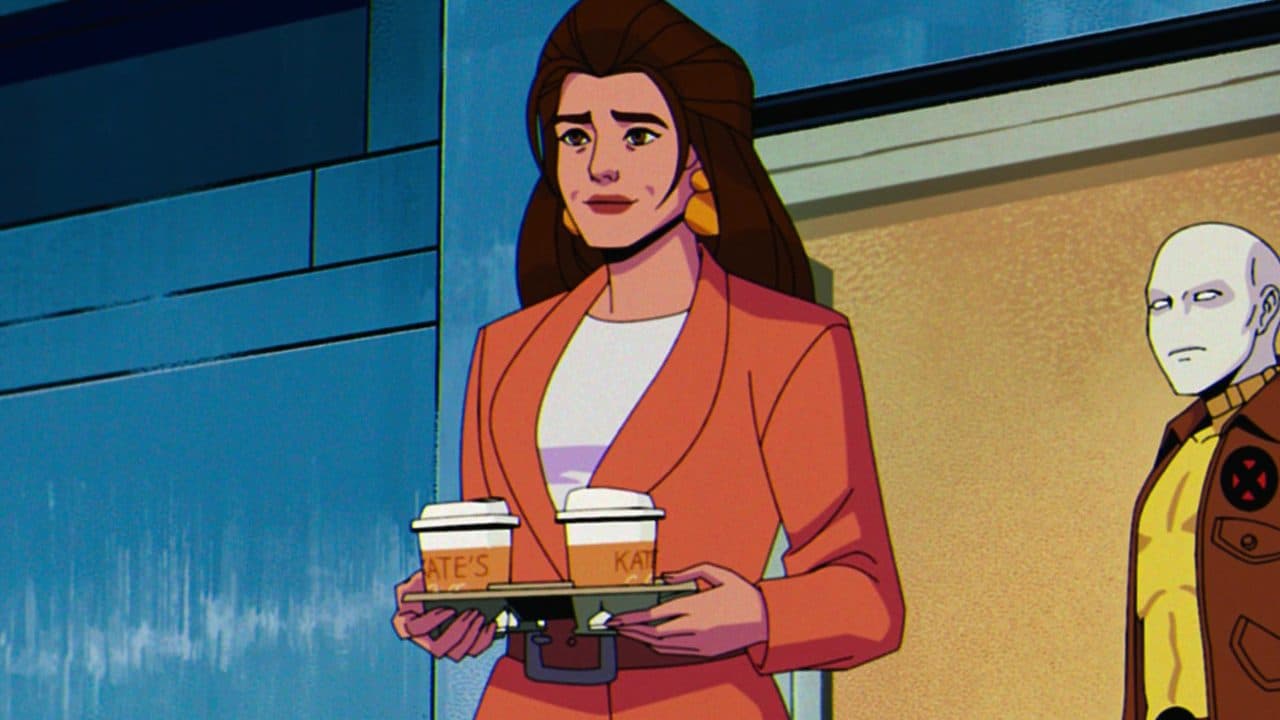
- Among the toys in Bastion’s childhood home is a doll of X-51, the Machine Man. Machine Man is an Avenger, X-Men ally, and Agent of S.H.I.E.L.D.
- Bastion is the result of Nimrod turning his father into an upgraded human, making Bastion the progeny of every sentinel that ever existed. The comic Bastion is also the result of a Sentinel fusion, though in that case, it was Master Mold and Nimrod being merged into one being via the Siege Perilous.
- There are cameos from Dr. Doom and Baron Zemo in Bastion’s meeting room. Doom, in particular, has a rich history with the X-Men. He once nearly defeated them during a begrudging alliance with Arcade that ended with him gaining a degree of respect for the team, especially Storm.
- The Sentinel depicted in Bastion’s “vision” strongly resembles Tri-Sentinel, a creation of Loki’s during the Acts of Vengeance crossover.
- Jubilee’s new costume is her post-2010 black and purple jumpsuit. The outfit is most strongly associated with her depiction after Curse of the Mutants, where she was infected with vampirism.
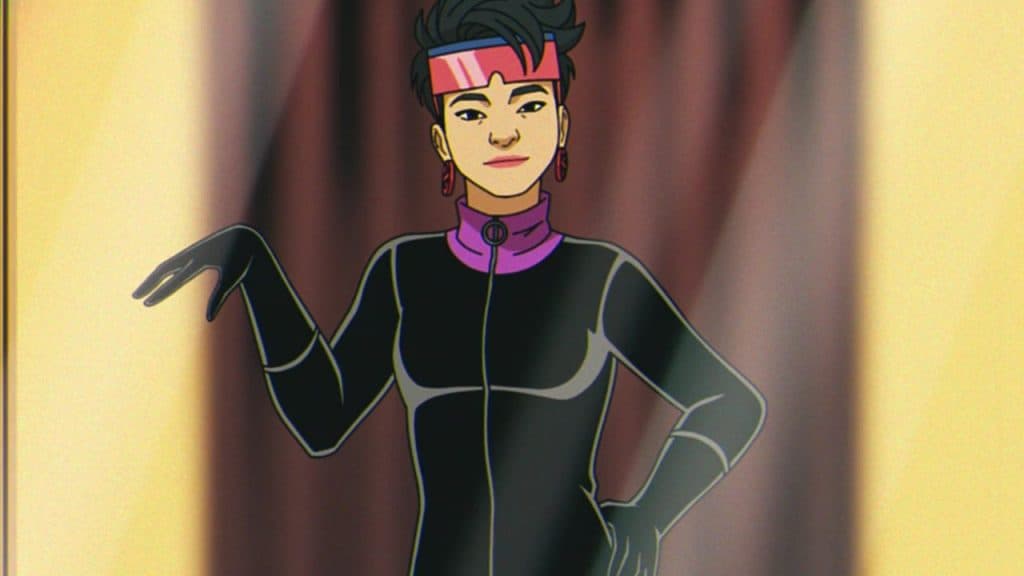 Jubilee gets one of her more modern outfits, a nod to a period of time in which she was a vampire.
Jubilee gets one of her more modern outfits, a nod to a period of time in which she was a vampire. - Morph shapeshift into the Juggernaut to fight the Prime Sentinels.
- Jubilee says she’s “totally done with malls.” This is not a reference to the fact that by 1997, malls were going out of vogue and would soon collapse under the strain of changing consumer needs, but rather to her own trouble being attacked by a Sentinel in a mall on the night she met the X-Men.
- We see how this version of Nightcrawler came to use swords. Kurt, in the comics, is often depicted carrying a cutlass or rapier, as he is a huge fan of pirate movies.
- We finally get to see Roberto’s full solar form here. The explanation for this form is that Roberto drains all the solar energy stored by his body to enhance his powers. This includes the ambient light from his skin, so he appears to be cloaked in shadow when at full power.
- Cyclops has a Porsche now. It could be because his previous car was destroyed by Wolverine in the original run of the animated series.
- More cameos at the end of the episode as Magneto fires off the EMP and wipes out power the world over, including Spider-Man (who is, of course, the version from 1994’s Spider-Man: The Animated Series, which had several crossovers with X-Men), Silver Samurai, and Omega Red.
X-Men ’97 Episode 9 Tolerance is Extinction Part 2 Easter eggs
- Storm’s role in the intro is updated with her new costume.
- Cyclops’ joke about black leather is a nod to a similar comment from 2000’s X-Men movie about that team’s black leather outfit.
- The rest of the X-Men get updated looks that match their appearances from the 1970s X-Men stories and the original X-Men animated pilot, Pryde of the X-Men. Morph’s costume is new but does get some very ’90s padded shoulders.
- The X-Men are split into Blue and Gold teams. These were the designations for the teams in the ’90s; Cyclops’ Blue team was in the adjectiveless X-Men comic, while Storm’s Gold team was in The Uncanny X-Men.
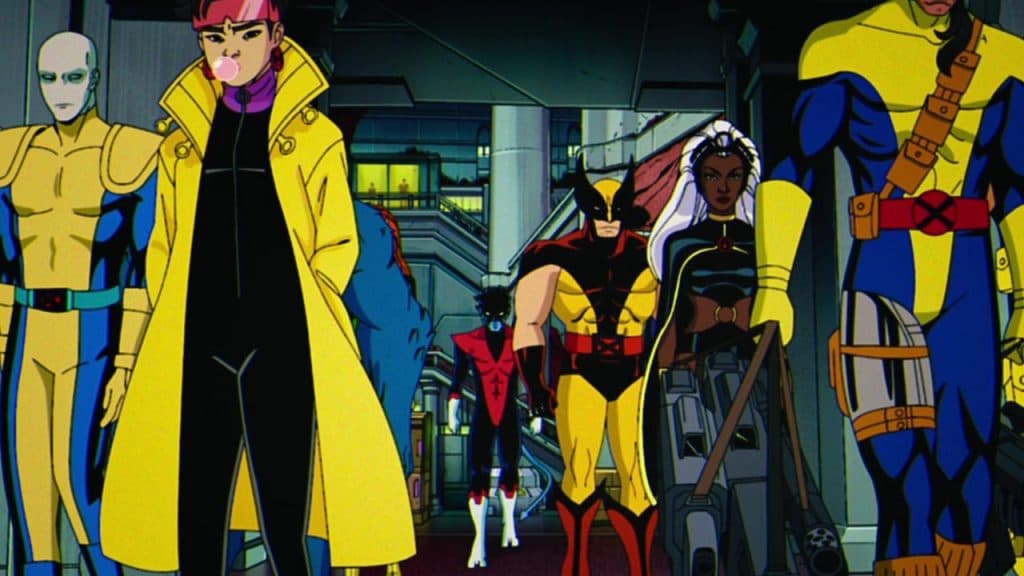 Everything old is new again when X-Men ’97 introduces classic costumes.
Everything old is new again when X-Men ’97 introduces classic costumes. - Morph shapeshift into The Hulk to fight the Sentinels. Though he never appeared on X-Men ’97, 1996’s The Incredible Hulk animated series is part of the shared universe of Marvel cartoons.
- Wolverine tells Magneto that the brave are the first to die in war. It alludes to a similar line in the original series’ first season finale, said by Magneto as he watched the X-Men fly off to fight Bolivar Trask and Master Mold.
- The episode’s finale is a loose adaptation of the Fatal Attractions arc, specifically 1995’s X-Men #25. In that issue, the X-Men attacked Asteroid M to stop Magneto. During the fight, an enraged Magneto rips the adamantium from Wolverine’s body. The event was a pivotal moment in Wolverine’s history, as it revealed more about his mutant powers, specifically that he had bone claws and not implants from Weapon X. It also revealed the damage the adamantium did to his healing factor, which was more powerful than ever afterward.
X-Men ’97 Episode 10 Tolerance is Extinction Part 3 Easter eggs
- A scene of a younger Xavier and Magneto is added to the intro
- Xavier using his powers to shut down Magneto is another nod to Fatal Attractions. This event causes Xavier and Magneto’s psyches to form a corrupted hybrid entity, Onslaught, who nearly destroys the world.
- Cameos galore in this episode! We again see Silver Samurai watching over Japan as the power is restored. We also see Captain America again, this time next to Iron Man. This version of Iron Man is from the 1994 animated series, which was part of the expanded Marvel animated universe that included X-Men and Spider-Man.
- We also see Daredevil, Doctor Strange, Cloak, and Dagger during the power outages.
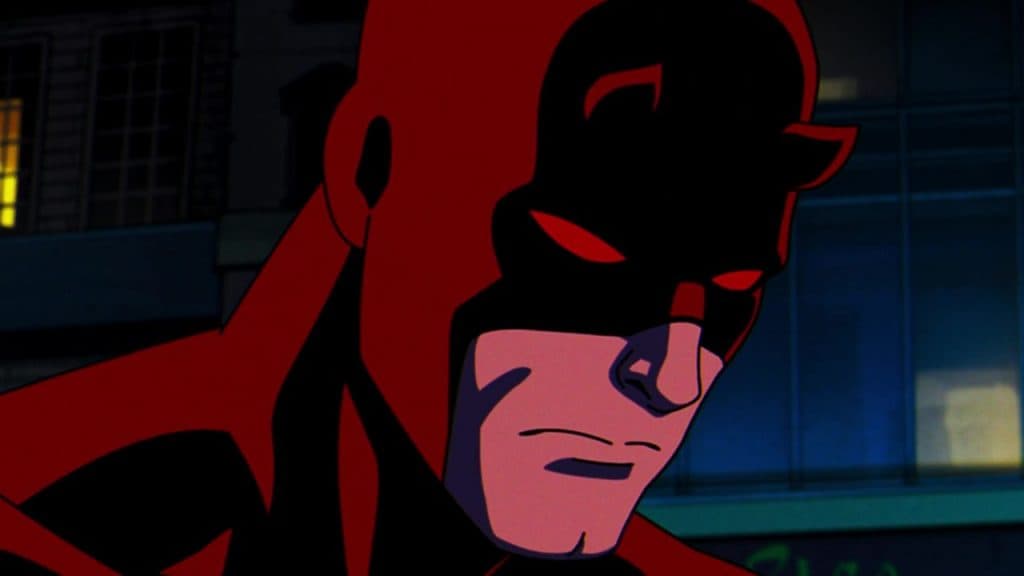 Daredevil makes a cameo in appearance in X-Men ’97’s finale.
Daredevil makes a cameo in appearance in X-Men ’97’s finale. - Bastion’s new look here hearkens to his Uncanny X-Force appearance.
- The Black Panther we see here is said to be King T’Chaka, which creates an odd timeline discrepancy. The 1994 Fantastic Four cartoon, which was also part of the Marvel animated universe, introduced a Black Panther who was T’Challa during its run.
- Omega Red, Crimson Dynamo, and Darkstar are seen fighting Sentinels. All three are superpowered individuals from Russia, with Omega Red and Darkstar being mutants.
- Psylocke is seen alongside members of Alpha Flight. While Psylocke is traditionally a member of Cyclops’ Blue Team in the ’90s, Alpha Flight is a government-sponsored Canadian superhero team. They’re most notable for being Wolverine’s team before joining the X-Men.
- Nightcrawler is seen with a rosary and saying a prayer. While the cartoon has made much mention of his swashbuckling side, Kurt, in the comics, is also a devout Catholic and respected priest.
- The folder on Magneto has two partially blacked-out names: Ian and Michael. These are nods to his live-action actors, Ian McKellan and Michael Fassbender.
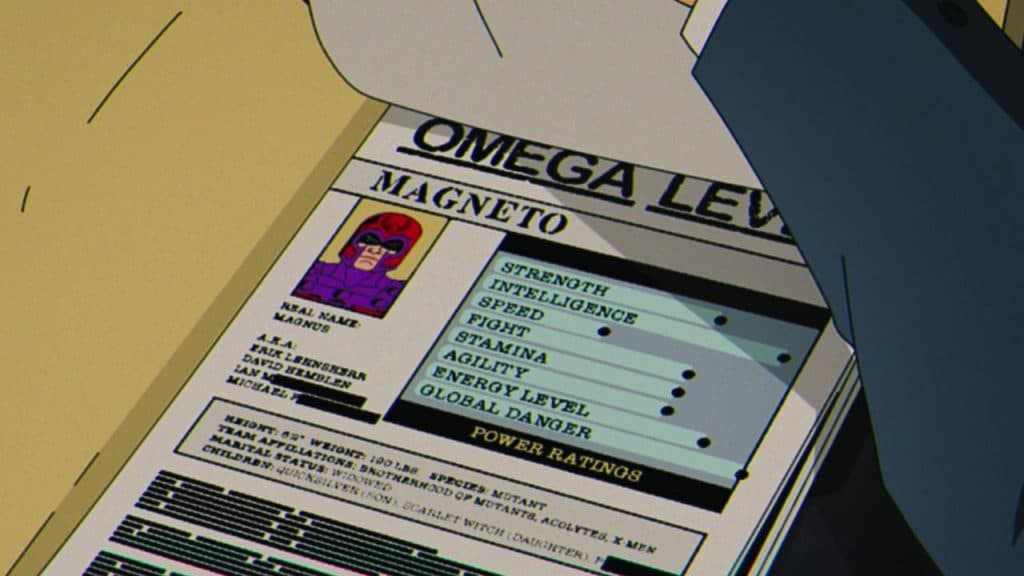 X-Men ’97 alludes to previous Magneto actors.
X-Men ’97 alludes to previous Magneto actors. - The Magneto Protocols from the comics are much more benign and are catalysts for the Fatal Attractions arc. They’re devices that alter the Earth’s magnetic field, preventing Magneto from returning to the planet from Asteroid M.
- Morph shapeshifts into Mr. Fantastic of the Fantastic Four to prevent being pulled into space.
- Jean telepathically holds back Scott’s optic blasts so he can see Cable without his visor on. The comics have had Jean do this on a few occasions, though it’s usually presented as a sign her powers are expanding under the influence of the Phoenix.
- Peter and Mary Jane of the ’90s Spider-Man cartoon are watching the news, while Eddie Brock walks behind them. Depending on when this show takes place, this is either the real Mary Jane or a clone.
- Forge’s wall of mutants is a nod to the iconic Days of Future Past cover, though in this case mutants are identified as AWOL or presumed dead rather than slain.
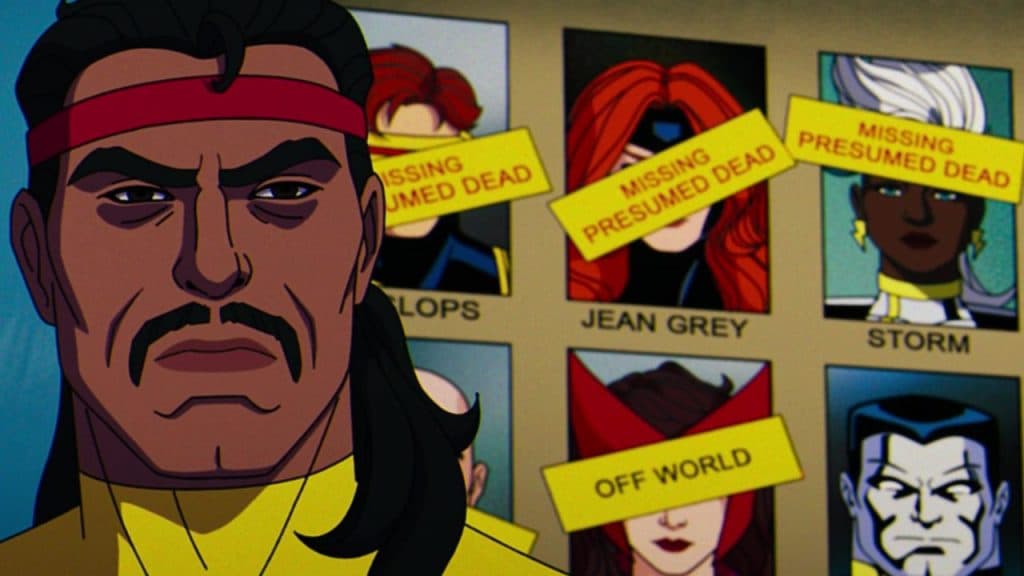 Forge is seeking missing mutants after the finale.
Forge is seeking missing mutants after the finale. - There are a few notable cameos on the wall, too, including Kitty Pryde, Colossus’ sister Magik, Cyclops’ brother Havok, and the original X-Man Iceman. Emma Frost also appears on the wall, though she appears to have traded in her ’97 look for her more modern, Astonishing X-Men-Era one.
- Cyclops and Jean are stranded in the future with Askani, who raised Nathan Summers in the future. The comics presented a similar storyline in The Adventures of Cyclops and Phoenix, wherein their consciousnesses were sent to the future to spend a decade raising Nathan.
- En-Sabuh-Nurr is the original name for Apocalypse, a mutant threat from the Egyptian era who would rule the world in one possible future.
- Apocalypse in the post-credit scene mentions death in Genosha while picking up a playing card. The comics saw Gambit become Apocalypse’s Horseman, Death, following House of M.
If you’re curious about more X-Men ’97 content, then read up on the comics that inspired X-Men ’97, or check out our further X-Men features.
X-Men Krakoa Age finale: Magneto’s resurrection, Iron Man’s downfall, & more | Marvel Comics’ Blood Hunt reading guide: Spider-Man tie-ins, Morbius’ return & more | Sabretooth War: Everyone who died so far in Wolverine’s bloodiest story ever